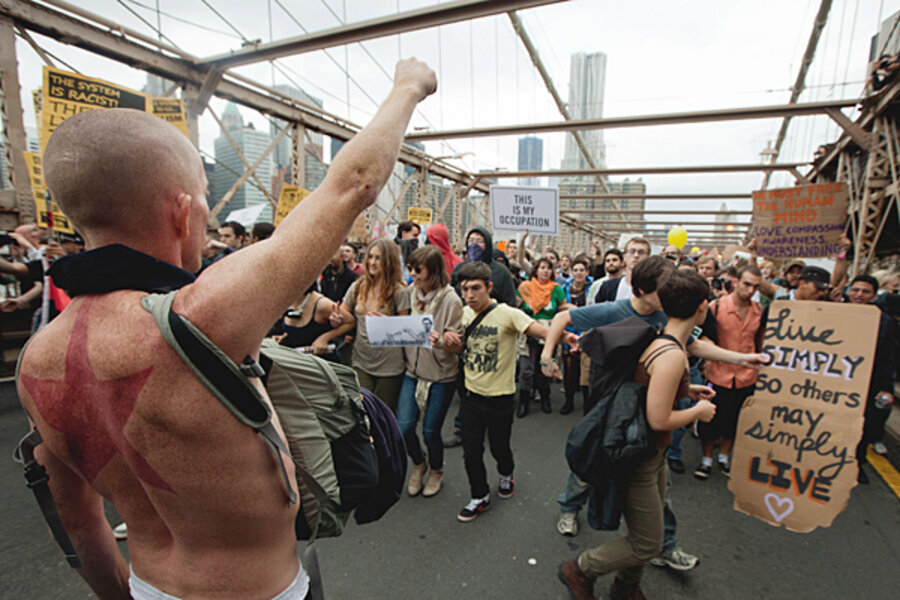'Occupy Wall Street': Why this revolution isn't made for TV
| Los Angeles
As the “Occupy Wall Street” movement catches fire, spreading copycat protests to towns and regions all over the globe, organizers and supporters say the mainstream media are not keeping pace.
Current TV’s Keith Olbermann lashed out at what he called a “media blackout” more than a week ago, and activist Michael Moore joined him two days later to rail against traditional media’s scant spotlight on the nascent protest movement.
But, polemics aside, is it really true that this revolution is not being televised? It turns out there are objective reasons the decentralized movement, which is protesting what it says is the undue political influence of major financial firms, has not generated more and better coverage.
According to the New York Observer, which has been keeping tabs on the media coverage of the Occupy actions, both broadcast and print media have been present from the inception, with ABC posting a blog and the local CBS affiliate airing a short clip on Sept. 17, the first day the group encamped around New York’s financial center.
Fox News, too, aired a bit about the anti-Wall Street activists on Day 1.
Tom Rosenstiel, director of The Project for Excellence in Journalism (PEJ) at the Pew Research Center, notes that coverage of the events involving the Occupy protests represented 12 percent of the economic stories, or about 2 percent of all the news studied in PEJ’s News Coverage Index last week.
“It is complicated and probably fraught to compare different news events that occur years apart,” he says via e-mail, “but that is more than the tea party received initially when it held its first rallies in February 2009.”
[ Video is no longer available. ]
However, the Observer points out, coverage is missing the bigger picture in favor of the simple narrative, noting, “when the shows started interviewing protesters, they were more focused on the actions of the police than what the protesters were fighting about.” This includes the YouTube video of a New York policeman pepper-spraying young women and the mass arrests on the Brooklyn Bridge over this past weekend.
No surprises there, says Mark Naison, a history professor at Fordham University in New York, who argues that broadcast media favor simple visual narratives. If the imagery does not lend itself to a quick explanation, and the subjects themselves intentionally represent many points of view, as is the case with the Occupy movements, then the journalist’s task becomes complicated.
“The media has focused on the pepper spray incidents and the arrests on the bridge because these are familiar to them,” he says, noting that there were issues of police mishandling of protesters in New York City when the Republican National Convention was held there in 2004.
But, he notes, the protesters themselves are not familiar.
“Middle-class, educated young people, many of them clearly countercultural in appearance – dreadlocks, tattoos, multicolored hair, etc., – all camping out in the heart of a city’s financial district, is not something anyone expected to see in the US,” he says. This is more familiar in Europe and Latin America, he notes, “but not in the USA.”
There is confusion, he says, adding that people are wondering, “Where did they come from? Why are they doing this?”
What reporters for the print and broadcast media are only now starting to grasp as this spreads nationwide, says Professor Naison, is how many middle-class college-age kids in the US can’t find jobs that secure middle-class status.
“In fact, there are enough of them to fuel a pretty big protest movement,” he says.
If the Occupy groups desire better mainstream media attention, they need to polish their communication skills, says Richard Goedkoop, a communications professor at La Salle University in Philadelphia.
“Part of its initial problem in gaining media coverage was its lack of a charismatic and quotable leader, which would allow news outlets to cover more than groups of (mostly) young people in centers of commerce,” he says via e-mail.
“Another problem is that the message behind these demonstrations have not been very quotable and precise,” he says. “What are they about? What do they specifically want?”
While news coverage is building, there could be more, he notes. “Supporters cynically might choose to blame it on the conglomerates that own these media organizations: Comcast, News Corp., Disney, etc.”
Because the brunt of the message is actually about them, he asks, “Is it in their best corporate interest to inform the public about their own failings?”
But if coverage is in fact skimpy, the reasons are likely more prosaic, says Mark Tatge, Pulliam distinguished professor of journalism at DePauw University in Indiana.
“The media that would normally cover this – mainstream media – is under severe economic pressure,” he says, pointing out that upwards of 30 percent of the reporters and editors who used to work for newspapers, TV stations, and magazines have been laid off.
“Ironically,” he adds, “some of these layoffs come at the hands of Wall Street investors who wanted fatter profit margins from media companies.”
If this says anything about media it is this, says Professor Tatge: “We are getting less coverage about events that predict or foreshadow what is yet to come.”





